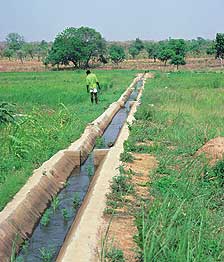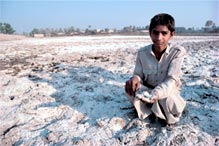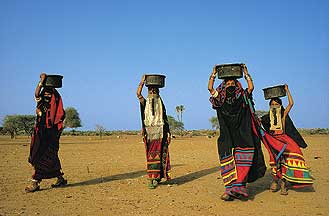|
|

|
� |
|
"The
world has no more fresh water than it did 2,000 years ago when the
population was less than 3% its present size" Alex
Kirby, BBC Environment.
| Click
here for a Data File on Water Resources |
The Unequal Distribution of Water
Globally
With
70% of the planet covered in water, it is hard to imagine that
there may be problems with the world's water supply. However,
less than 3% of the earth's water is fresh, and most of this is
difficult to obtain. At the same time, water supplies are very
unequal on a global scale, depending on the differences in climate,
and the balance between the amount of precipitation on the one
hand and the loss of moisture from the soil, rocks and plants,
known as evapotranspiration, on the other. In much of the Middle
East, evapotranspiration is higher than precipitation, creating
a water deficit. In North-West Europe, the opposite is the case
and we benefit from a water surplus.
| What
are the sources of fresh water? click here to find out. |
...and
Locally
Distribution
of water on a local scale is not just a result of nature. People
who live upstream of a river may use up or waste water at the
expense of people who live further downstream. Even in arid
areas, there are richer people who have all the water they need.
Meanwhile, poorer communities have the greatest difficulty in
having enough water. In water-scarce western India, powerful
irrigation pumps work twenty-four hours a day, while poorer
women find their drinking wells run dry. Therefore water shortages
are often as much to do with inequality amongst people as well
as the natural conditions of an area.
Wasted
Water
For
thousands of years, people have been developing ways to extract
water from rivers and the groundwater supply to irrigate the land.
Large-scale development projects using mechanical pumps have made
irrigation much easier but there are signs that they can create
problems as much as solve them. Some rivers have been reduced
to a trickle by the time they reach the sea. In parts of China,
India, Mexico and Yemen, water
tables are dropping by a metre a year as people pump up waterfrom
underlying aquifers.
�
 |
|
�Bruce
Paton/Panos Pictures
|
| An
irrigation channel in Tamale, Ghan. |
�
To
make matters worse, scientists have discovered that only 15% of
the irrigation water is actually taken up by crops. The rest either
evaporates or escapes through broken pipes and unlined channels.
This inefficient management of water can lead to two twin problems,
waterlogging and salinisation. When too much water flows over
the land it can become waterlogged, and crops quickly rot and
die. Salinisation occurs when the natural salts contained in irrigation
water seep into the ground and build up in the soil, making it
too salty (saline) to grow crops.
�
|
Click
on the picture for a larger image

|
|
�
Jim Holmes/Panos Pictures
|
| In
the Indus valley, Pakistan salinisation is a major problem
for farmers. Hot temperatures cause the water in the soil
to evaporate. As a result, the salts are left behind and ruin
the farmland. |
�
Water
Security for All
|
Article
24 of the 1989 United Nations Convention on the Rights of
the Child stated that every child should have the right
to clean drinking water...
For
more information on the Convention, look at
www.unicef.org/crc
|
In
March 2000, over 4,000 representatives from governments, private
businesses, international and non-government organisations met
at the World Water Forum in the Hague, Holland to discuss the
future of global water resources. A common goal was to find ways
in which everyone has access to safe water at an affordable cost
without causing irreversible damage to the natural environment.
This way, water management would be more sustainable.
'Water
security for all' is not easy to achieve, but many experts at
the conference recognised that water management must be considered
alongside other development needs to enable people to escape
a vicious cycle of poverty. Improving access to clean water
frees up time for other things rather than collecting water
like growing food and expanding new income-generating businesses.
At the same time, reliable, clean water greatly reduces the
risk of catching water-related diseases that prevent people from producing
food and earning a living.
Building
on Local Expertise
Instead
of investing in large-scale irrigation projects, maybe the answer
to long-term water security is to put water management in the
hands of local communities. After all, it is local people who
have the best idea of what they need and they have to manage
their water needs on a daily basis long after the experts have
gone home. Crucial to this is the involvement of women who despite
playing a vital role in water use are often left out of any
decision-making to do with water.
 |
|
�Caroline
Penn/Panos Pictures
|
| Women
in arid parts of Sudan can spend as much as six hours a
day collecting water. |
Already
local expertise has been used to make more efficient use of
valuable water, such as ways of capturing water before it is
evaporated or drained away. This is known as water harvesting.
Similarly, locally made hand pumps are easier to maintain, therefore
they have a better chance of sustainability.
Combining this local technical know-how with modern technology
could enable new cheap and locally managed schemes without starting
from scratch. To give you an idea of how this can work in practice,
have a look at the Marunda Project
case study.
�
|
|
�

|
� |
|

